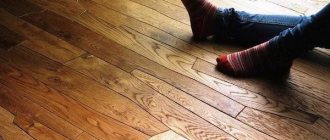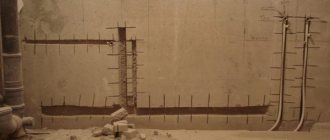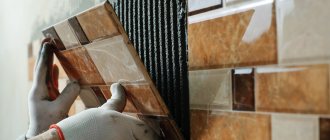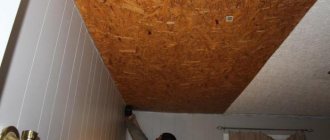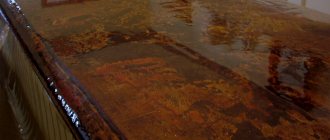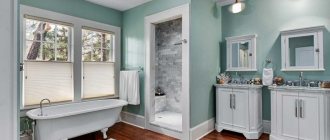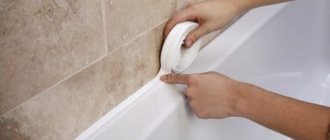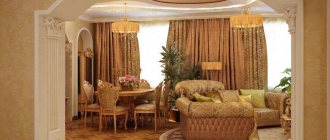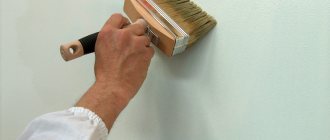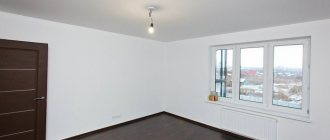Beton-House.com
Website about concrete: construction, characteristics, design. We combine the experience of professionals and private craftsmen in one place
Decorative concrete is an interesting and extraordinary way of interior design
Concrete is the most popular building material - it is used in the formation of foundations, the construction of walls and the construction of floors. But not so long ago the texture of concrete itself was considered very unsightly and required mandatory decoration. Modern designers, on the contrary, are increasingly incorporating raw concrete into interior design solutions.
Modern textured concrete has become indispensable in creating rooms in the loft, high-tech or modern style. If this design of walls or ceilings suits you, in our article we will tell you in what ways a concrete texture can be created, what materials can be used for this, and what points are the most important when working with concrete.
- Mineral plaster
- Concrete plastering technology
Description of material
Concrete has a characteristic, easily recognizable texture. It is slightly rough and has large and small pores. Its heterogeneous gray color belongs to the cold palette. Outwardly, all this looks unattractive, but at the instigation of the Japanese architect Tadao Ando, concrete began to play a fundamental role in the interior of living rooms. This was a bold decision; the master used it to create a trendy look for the house. Today this finish is very popular. It is chosen by creative people, extraordinary individuals who surround themselves with an exclusive space.
Monochrome cool color Source designerdreamhomes.ru
Concrete is a plastic material; when used correctly, it can reveal completely different properties. Modern designers today do not hide traces from the formwork structure, do not mask joining seams, on the contrary, they play up their presence in every possible way and, using other techniques, break stereotypes. Today, concrete walls in the interior look soft and warmer due to the placement of the right accents. Soft carpets, delicate textiles on the windows, velvety upholstery - all this prevents the atmosphere of a gloomy basement or bunker from forming.
Individual decorative elements soften the severity of concrete Source dhfa.mx.tl
Concrete goes well with other finishing materials. Its expressive texture emphasizes the warmth of wood and the severity of glass. This tandem became the basis for the implementation of industrial styles. If loft or constructivism, or any other rigid brutalist concept, is chosen for interior design, concrete must be used.
Decorators do not hide defects in the concrete surface, but emphasize them Source pobetony.expert
Execution options
Today, you can use different techniques to create the desired effect. If there is a need to make walls look like concrete in the interior of a monolithic new building, you can leave the surfaces untreated and only lightly work on them. To do this, you will have to clean the walls with a spatula and cover them with colorless varnish. This will help prevent the absorption of moisture from the air and the appearance of mold in the pores of the material.
concrete-look walls in the interior Natural concrete in the interior Source kuchen.access.ly
If the concrete walls were finished with plaster and wallpaper, you will have to work and remove all the layers. It is important to expose the base and see what condition it is in. When the wall is completely open, experts recommend repeating the steps described above: treat the base with a hydrophobic compound and cover it with a layer of colorless varnish.
Gray surface coated with varnish Source topwebhosts4u.info
There are cases when exposing the wall reveals the presence of hidden defects (the appearance of cracks, for example). In such a situation, it is better to design using pure concrete and cover the entire surface of the wall with a thin layer. This work is labor-intensive and dirty. Therefore, many people prefer to choose other finishing materials that allow them to imitate the desired texture. It makes sense to talk about them too.
Exposed concrete is also beautiful Source altamareabath.it
See also: Catalog of companies that specialize in finishing materials.
Imitation concrete
There are several ways to solve this problem using simpler methods. Each has its own merits.
Plasters
The easiest way to imitate concrete is to use plaster mixtures. The choice of a specific composition should determine the functionality of the room. For example, it is better to use cement plaster to decorate the walls in the kitchen. It will create a scratch-resistant coating.
Cement plaster on walls Source steeledavis.co.uk
In order to protect it from moisture, you will have to varnish the wall. But even in this design, cement plasters cannot be used to decorate the bathroom. Here it is better to use lime-marble mixtures, which allow you to create matte and glossy textures. To imitate concrete in the bedroom and living room, experts recommend using lime plaster. It is an environmentally friendly material that allows for safe finishing. Using special methods of applying mixtures, craftsmen achieve complete resemblance to natural, pure concrete.
This is what concrete plaster looks like Source concretewall.no
Note! Manufacturers have been producing decorative plasters for concrete for a long time; they allow you to create different effects. The appearance of the finished finish depends on the fillers present in the mixtures.
Accent walls created using decorative plasters Source ar.pinterest.com
The use of decorative plasters helps improve sound insulation and reduce the thermal conductivity of walls. After their application, a finish with shallow relief is formed. It goes well with other traditional finishing materials (wood, tile, metal, glass). Gray color has a huge number of shades. It is possible to choose cold, lifeless halftones or colors that are closest to the warm palette.
Different textures of decorative plasters Source o-remonte.com
You can apply decorative plaster to the walls, creating layers of different thicknesses. Using this technique, craftsmen achieve special decorative effects (new, aged, washed-out concrete, torn, with stains, with traces of formwork). The coating is seamless and textured.
Smooth, seamless surface Source joergjermann.ch
Concrete as it is
It is worth immediately noting that despite the simplicity of working with the solution, the formation of a surface that does not require subsequent decoration is a very complex process. If you plan to leave the surfaces unfinished, then you should take care of this at the design stage.
The fact is that after removing the formwork, there remain on the concrete the gaps from the fastenings, as well as the seams from the panels. It is these details that make the surface interesting and individual. These marks cannot be corrected or changed in any way, so it is worth arranging formwork based on the consequences.
Any removable formwork leaves individual marks on the concrete
Communications
Another important point when creating concrete interiors is the need to lay channels for communications before pouring the solution. A finished wall cannot be tapped, because it is impossible to unnoticeably restore the integrity of the surface.
Even before construction begins, it is necessary to determine the location of:
- lamps,
- sockets,
- thermostats,
- air conditioners,
- sewer outlets,
- water pipeline
After identifying the points, communication channels are connected to them - and only after that the formwork is installed and concrete is poured. Those who want to get concrete whose texture does not require any additional processing must calculate their actions down to the millimeter.
In addition to communication inputs, it is important to determine:
- places and direction of joining seams;
- shape and number of shield fastening elements.
It is these recesses that will create the individual character of the surface.
On a note! Such a surface can be created not only in the interior. This solution looks very interesting in the design of facades.
Facade of the conference and meeting pavilion in Weil am Rhein
Concrete walls in rooms of different purposes
When the entire apartment is decorated in the same style, it helps to create an ideal harmonious space in which it is convenient and comfortable to live. And for this you do not need to use the same finish everywhere. There are many ways to support the chosen stylistic concept using different materials. Concrete is usually used sporadically in city apartments. They decorate one or two states. Practice shows that such decor will be appropriate in any room.
Interior with concrete walls Source pinterest.com
If it's a living room
The monochromatic surface creates an accent background that can work independently. But sometimes, to maintain style, it becomes necessary to dilute the monochrome of gray. We can talk for a long time about how to decorate a concrete wall. The easiest way is to hang a bright picture or panel on it. A large mirror will also look beautiful.
The texture of a cold surface is best emphasized by daylight and artificial lighting. If its flow is directed correctly, the rigor and restraint of the finish will come to the fore. The living room is a general purpose room. Here you can neglect warmth and comfort in favor of style, so you can safely use a concrete finish.
Strict brutal living room Source kvartblog.ru
Concrete in the interiors of premises for various purposes
Unusual furniture and paintings look especially impressive against the background of a concrete wall.
Concrete walls can be used in any room of a residential building, giving them a special personality and chic.
Living room
Overlay decorative panels contrasting with the concrete texture of the walls in the living room
For a living room with a concrete wall, you can use any design solution, but the most harmonious and natural would be minimalism or loft style. A plain concrete surface can be used as a background to create an expressive, eclectic interior.
A fur carpet on the living room floor with concrete surfaces, together with a leather sofa, gives warmth and a cozy atmosphere
The shade of concrete walls depends on the size and lighting of the room. In a small living room, you can select one concrete wall as an accent wall. Microcement plaster is suitable for this, creating coatings of different colors.
Kitchen
Bright glossy countertop in a concrete kitchen
Against the background of concrete walls in the kitchen, you can use furniture from any materials and their shades. The white glossy surface of the kitchen facades can be effectively shaded with the noble gray color of the concrete walls.
Bright laminated facades or natural wood will look no less expressive against such a background.
Combination of glossy white facades and concrete
Important! To prevent the porous concrete wall from becoming dirty in the kitchen work area, you can use a kitchen apron made of tempered glass - skinali. This will preserve the expressive texture of the concrete wall and protect it from moisture and grease.
Industrial kitchen style
To make the kitchen interior look more harmonious, you can use concrete furniture elements, for example, a bar counter or countertop.
Bedroom
Natural wood in a bedroom with a concrete wall
Despite the fact that traditionally soft pastel colors, textiles and pieces of furniture that induce psychological relaxation are chosen for the bedroom, the rough surface of concrete has also found application there.
Organization of lighting for decorative ceilings and sleeping areas
You can soften the visual perception of concrete walls in the bedroom using textiles with a pronounced texture (wool, flannel) and decorative elements - fur in the form of an animal skin on the floor or on a chair.
Warm textures in a concrete bedroom interior
Warm-colored wood will also make the interior cozier and warmer - this could be parquet flooring, furniture or decorative fragments on the wall - baseboards, moldings.
Bathroom
Concrete Bathroom
Properly treated, concrete can withstand intense moisture. Against its background, the glossy surface of the plumbing equipment looks advantageous.
Bathroom textiles, towels, and wooden finishing elements will add softness. A countertop with a concrete sink will look harmonious in such an interior.
The photo below shows options for using concrete surfaces in the interior.
Often, objects need to be secured to a concrete wall. It is impossible to talk about everything at once within one article. But instructions on how to secure a horizontal bar in a concrete wall, or how to attach the sheathing to concrete if you want to cover it with plasterboard or wood, can always be found on the pages of our website.Generalization on the topic
Don't be afraid to use rough finishes. The article showed how impressive, beautiful and stylish concrete walls look in the interior - how to treat them to extend the life of the finish is also very clear. Treatment with a hydrophobic composition and varnish is considered mandatory if there is a high humidity threshold in the room.
A little more attention!
Write in the comments what you think - such simplifications of design make it stricter and more beautiful, or is it better to look towards proven classics?
Ratings 0
Read later

